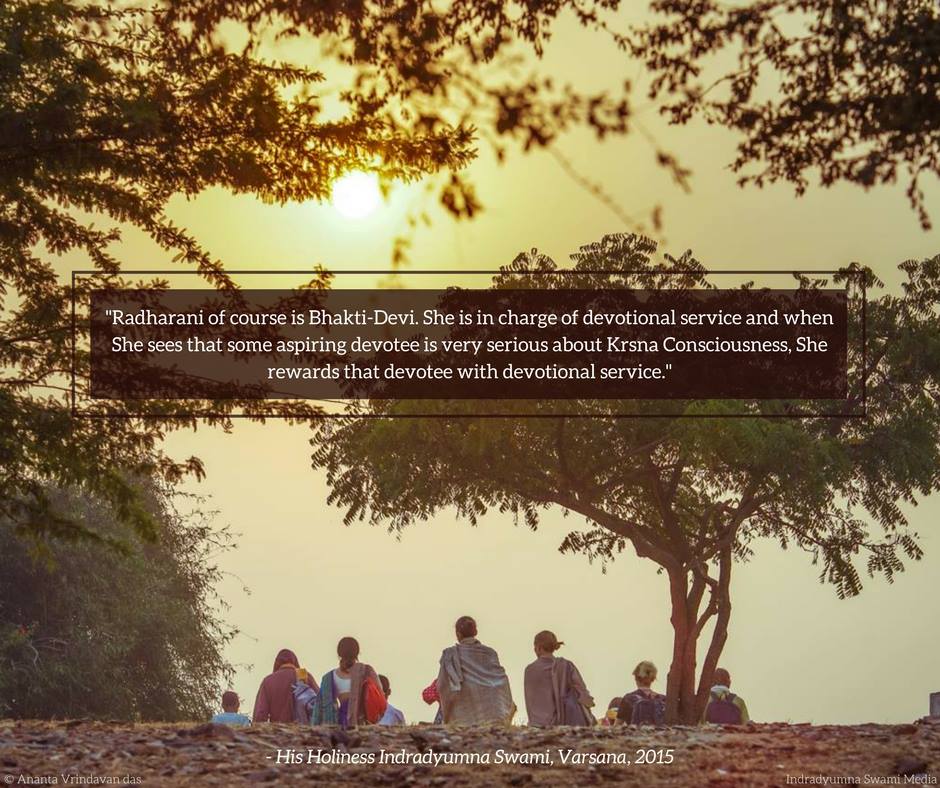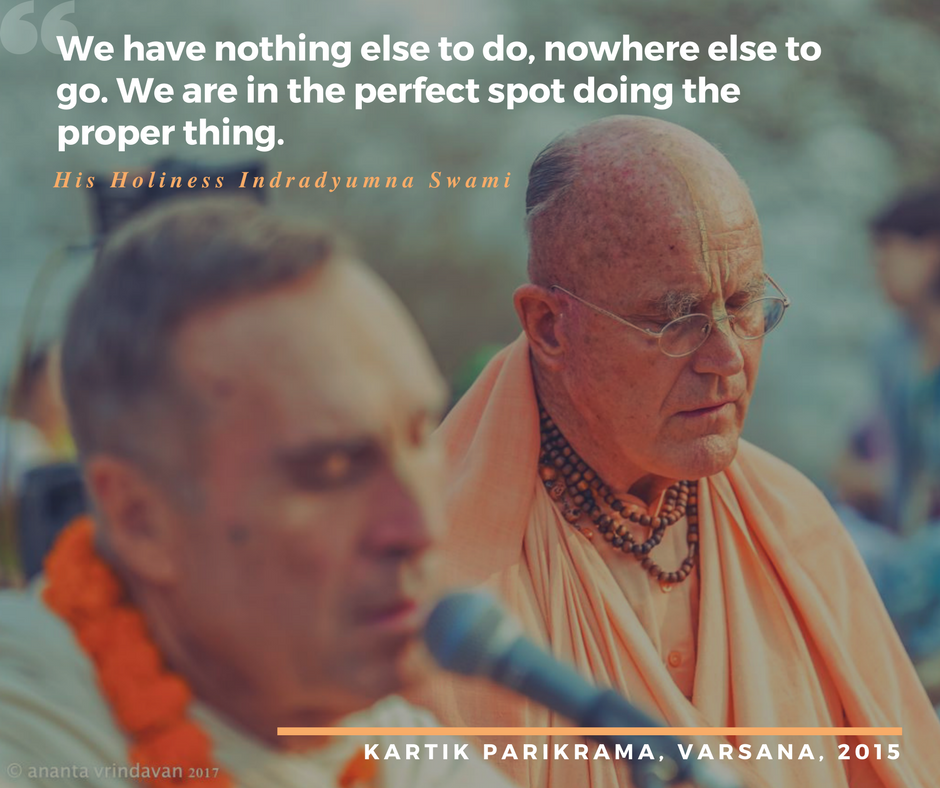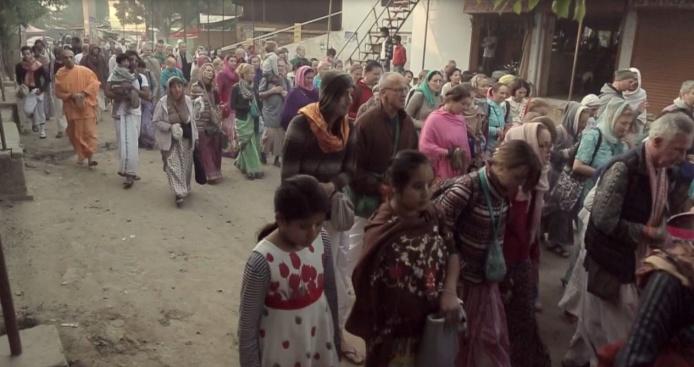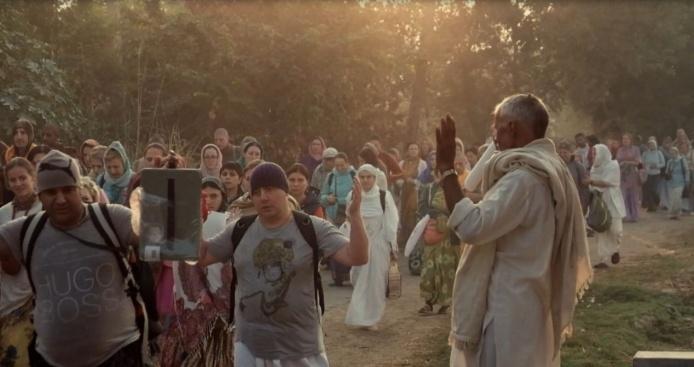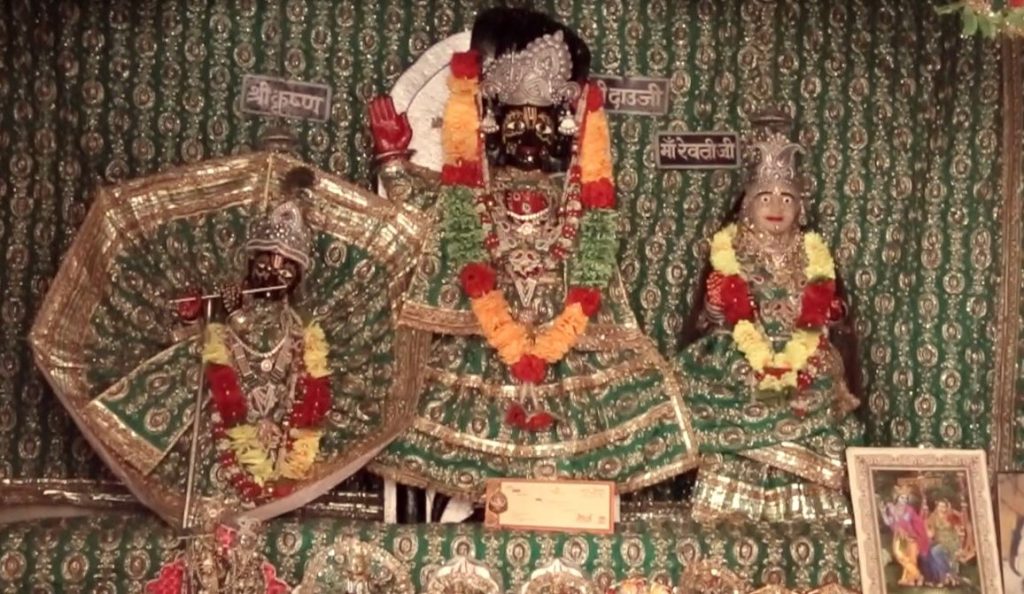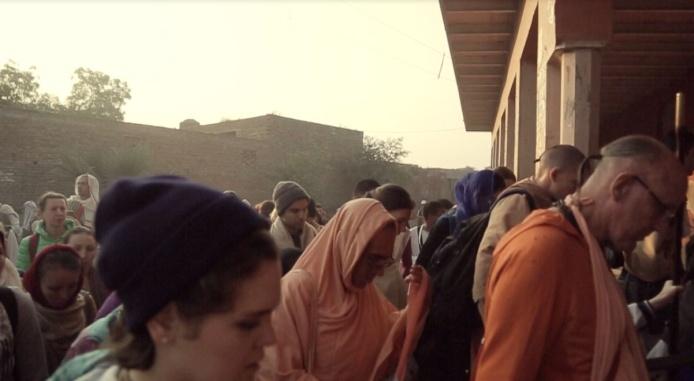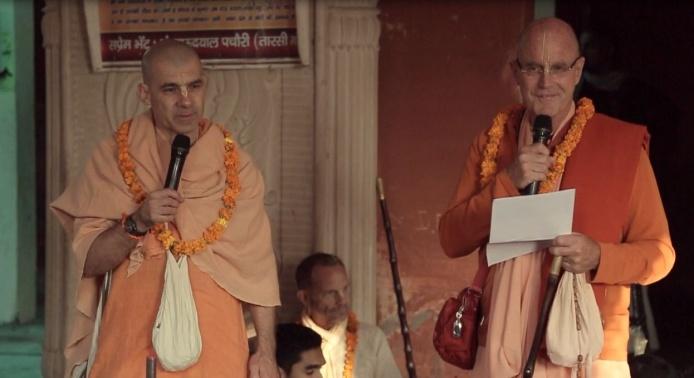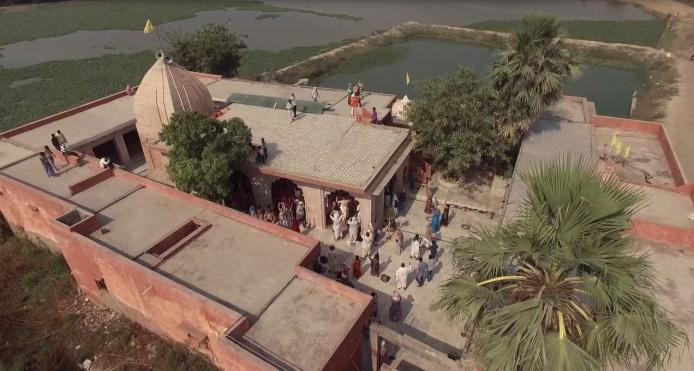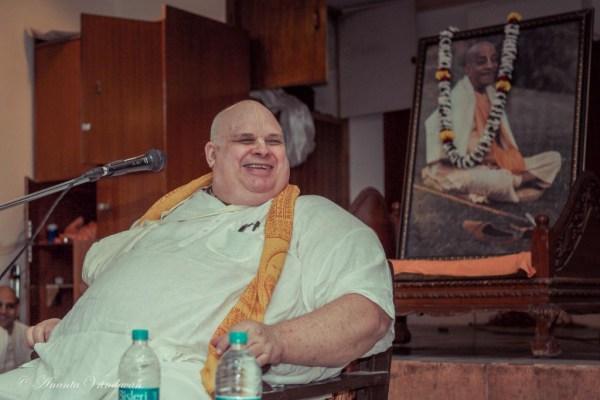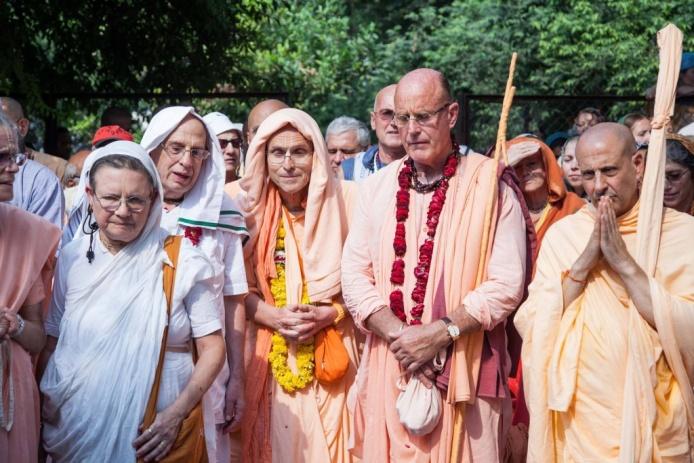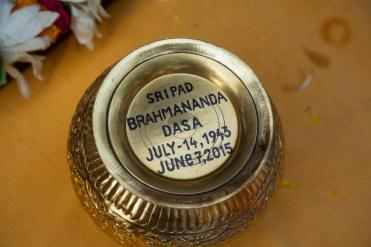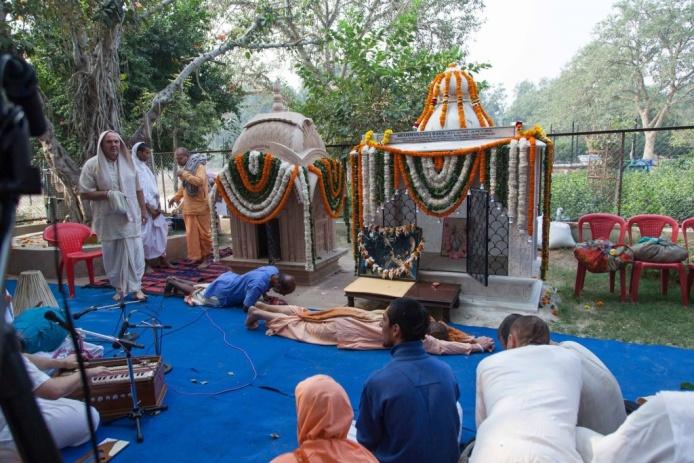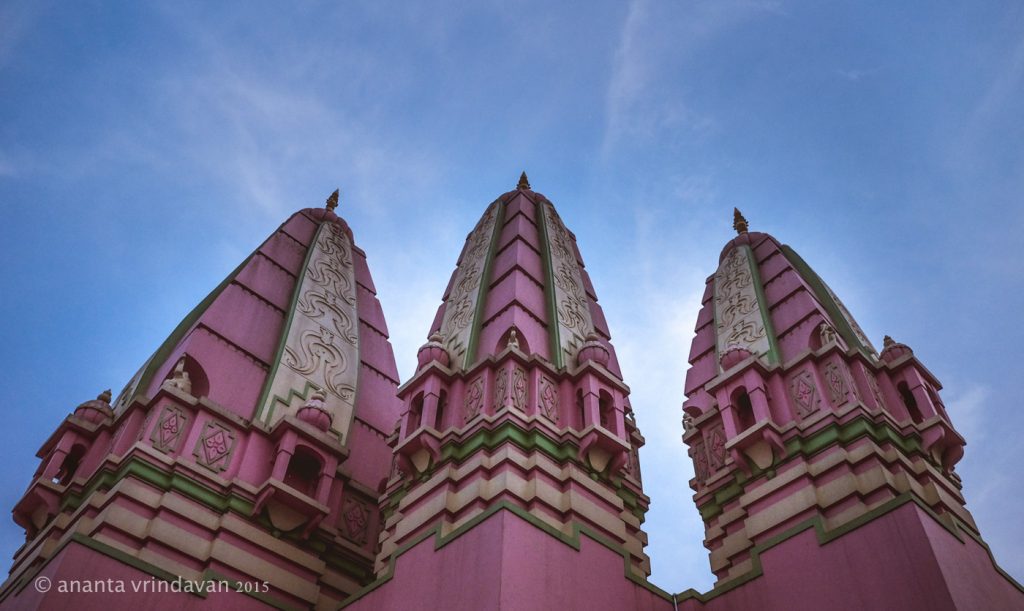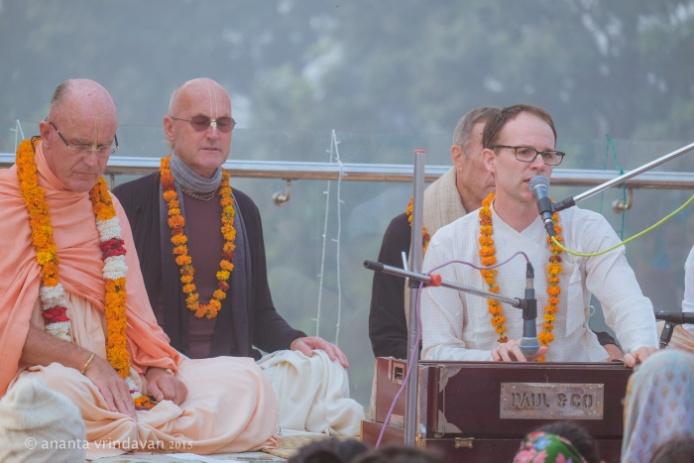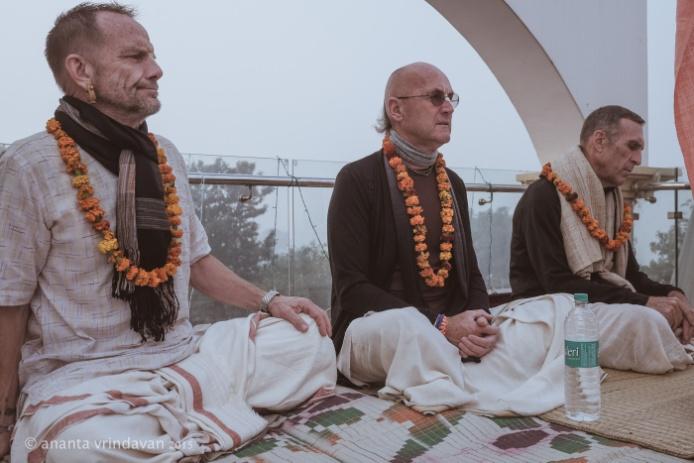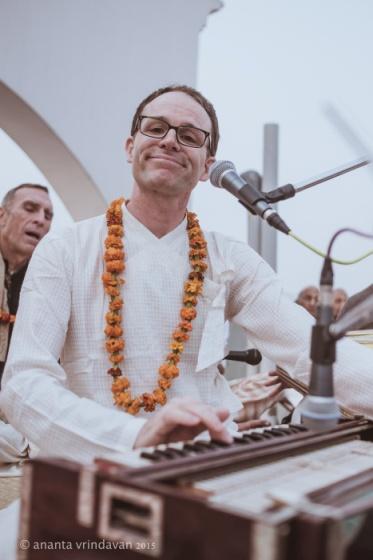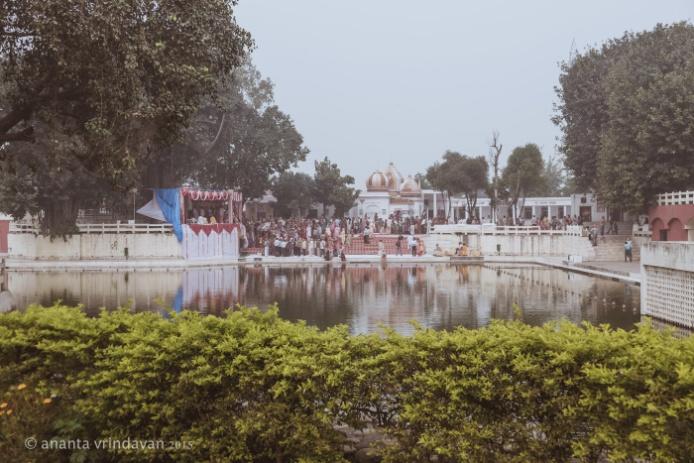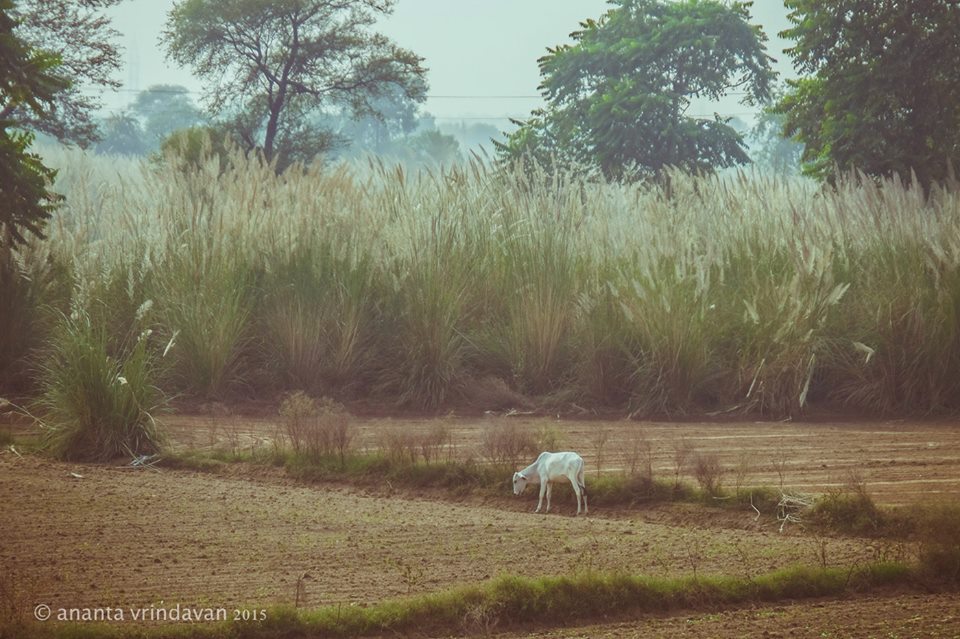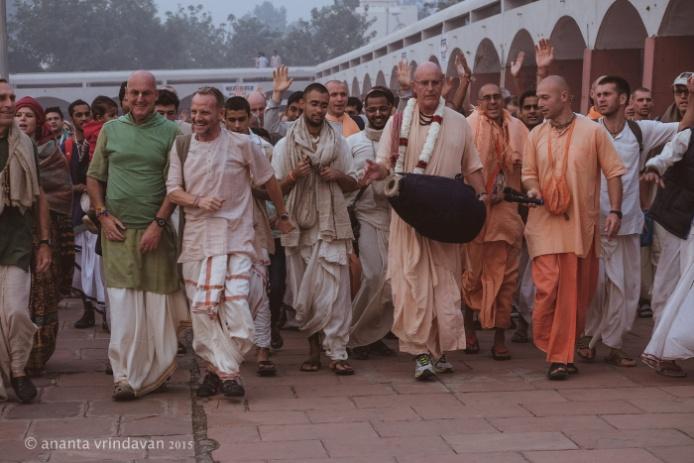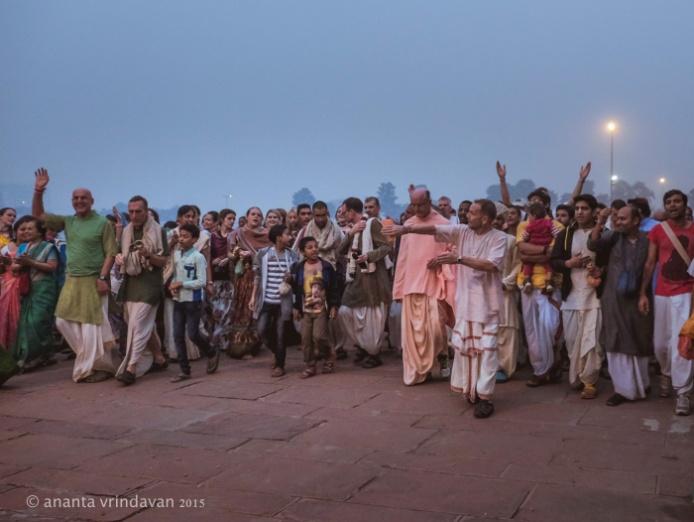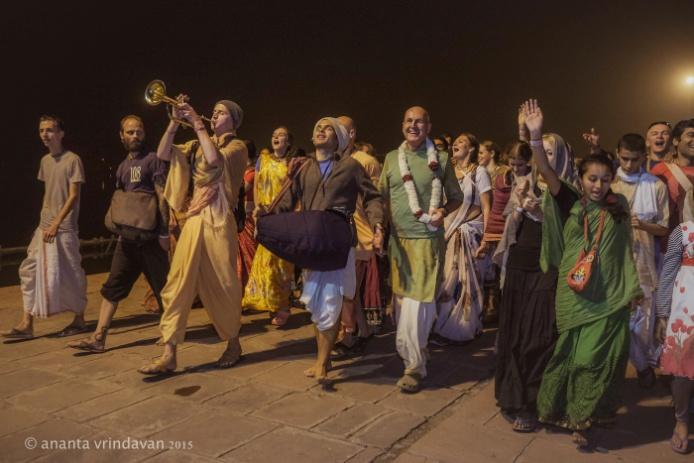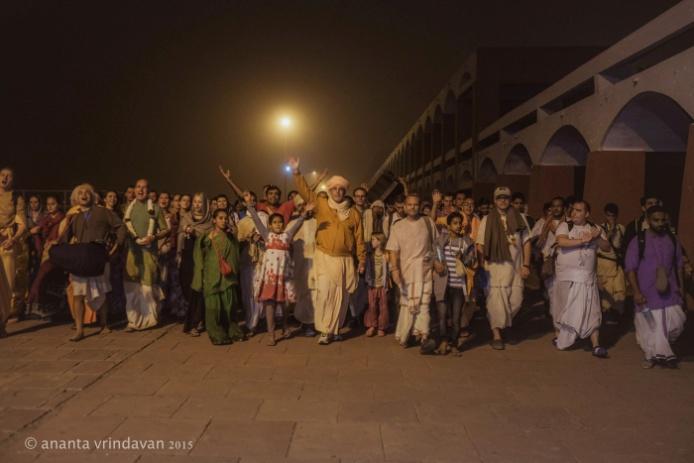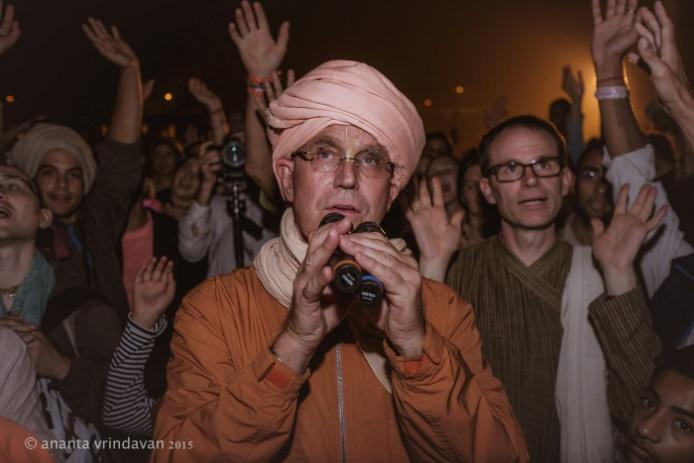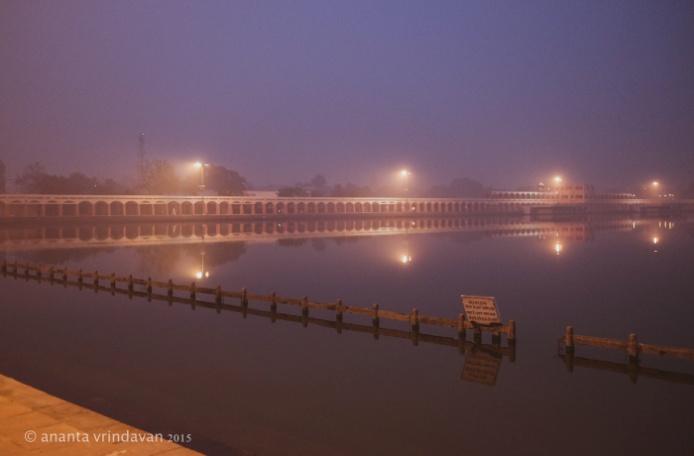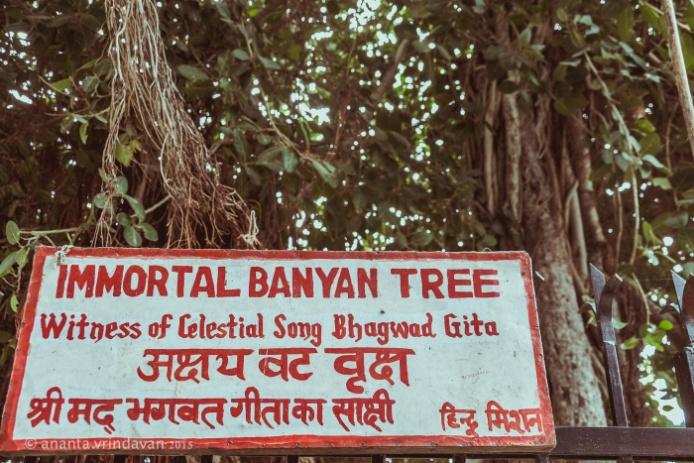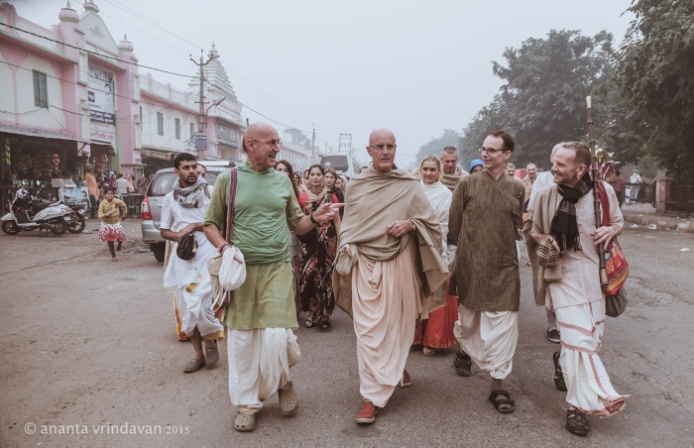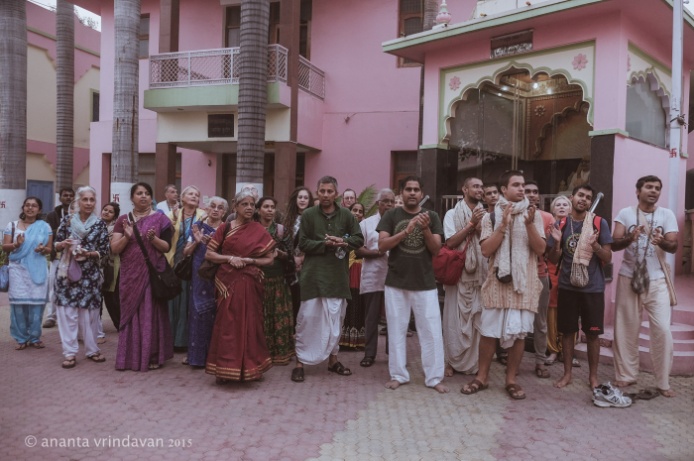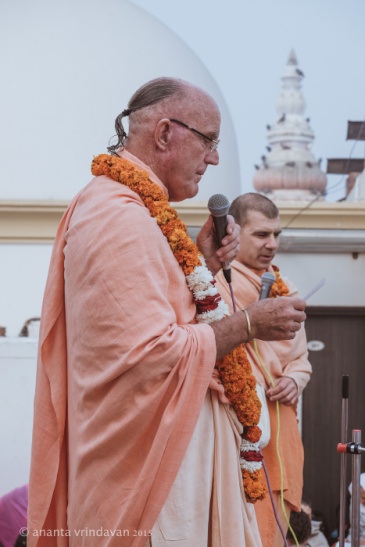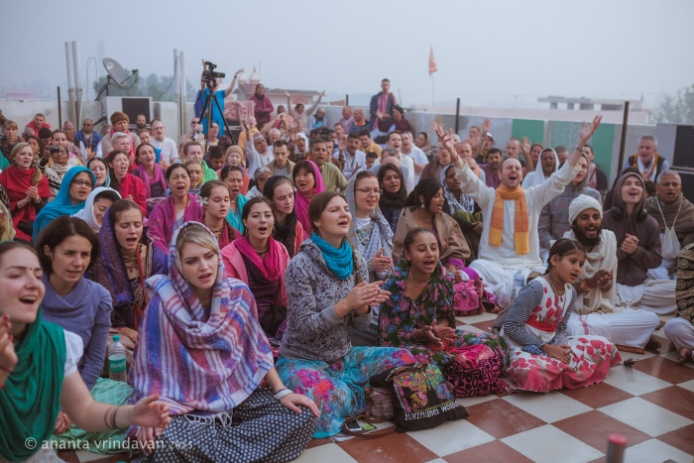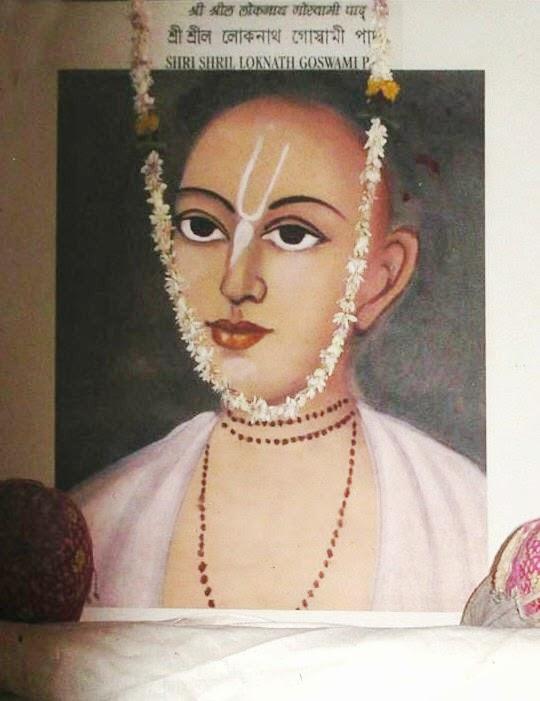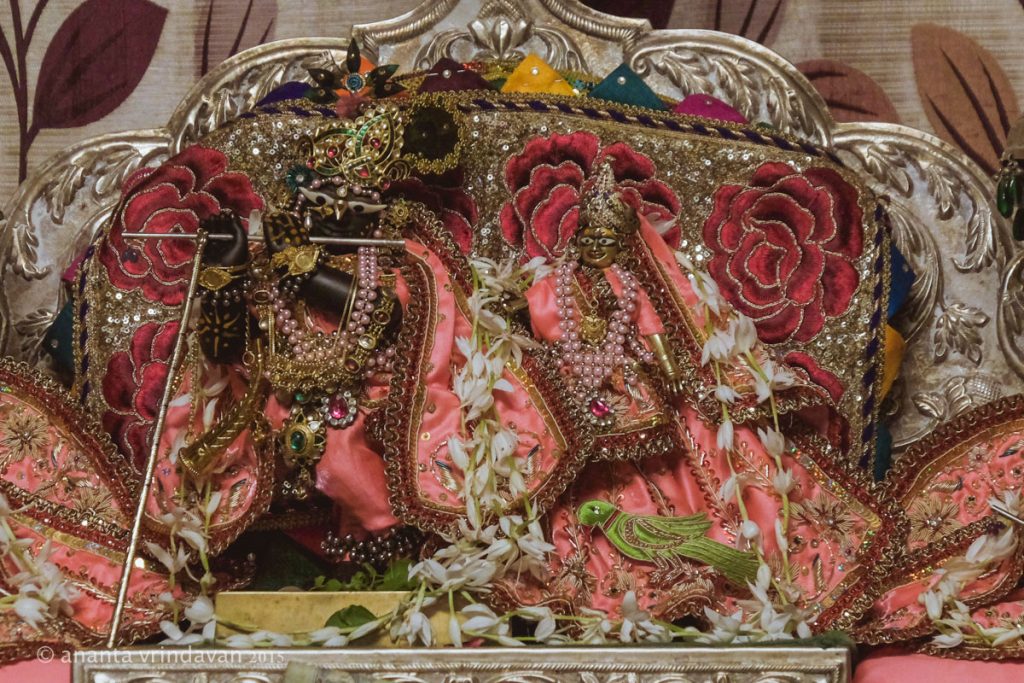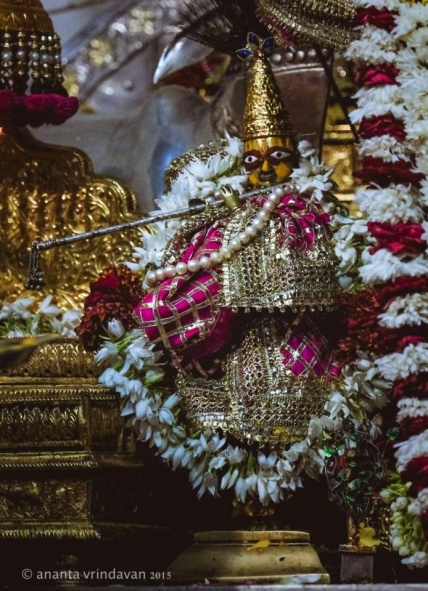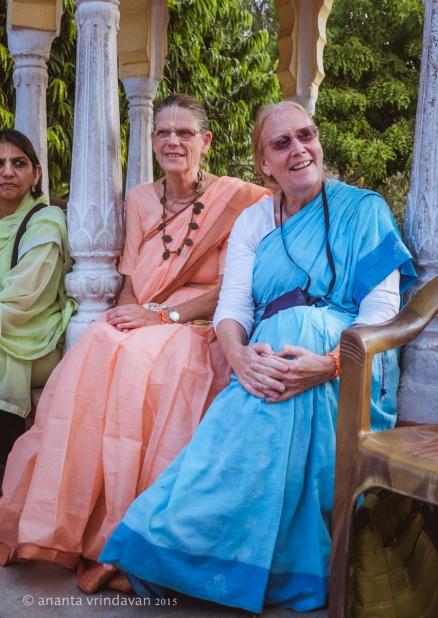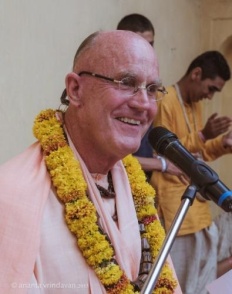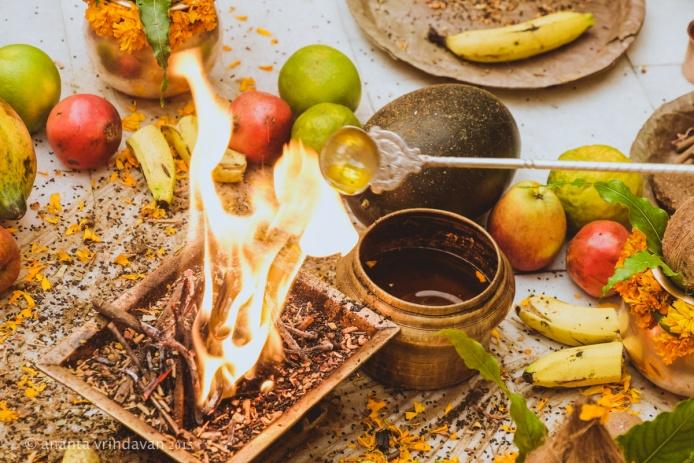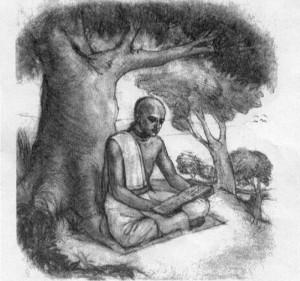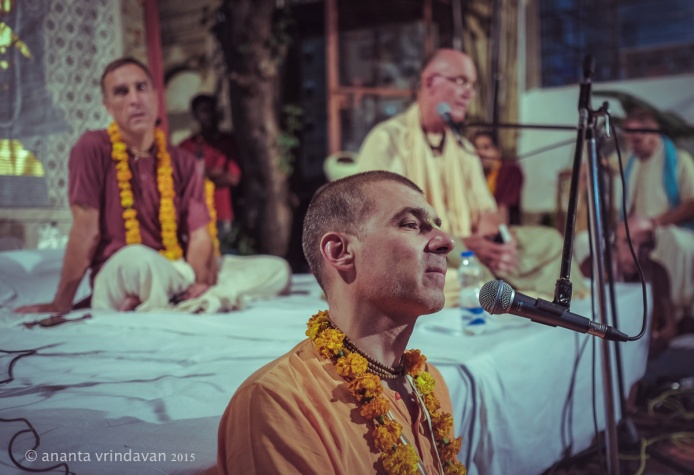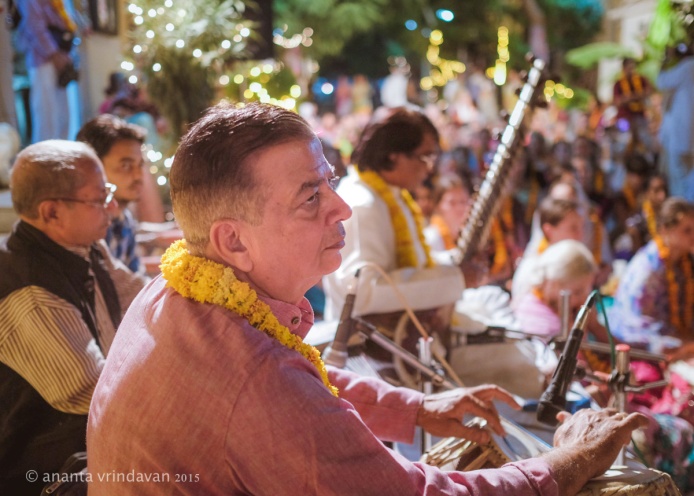Rādhā: Tattva, Rasa, and Kṛpā
– By HG Śrī Prahlāda Prabhu
We are so fortunate to be gathered here at Kṛṣṇa–Kuṇḍa in Varṣāṇā. By what good fortune, what pious activities have we done to find ourselves in this situation? What austerities have we performed? Maybe we gave lots of charity. Actually none of these activities can award us the great opportunity, the great benediction that we are experiencing at this moment. It’s only by the mercy of the Vaiṣṇavas. Bhakti is the most valuable treasure and no amount of piety, no amount of austerity, no amount of charity can award one this treasure. There is nothing we can do to make ourselves eligible. How then is it ever received? – Only by the mercy of compassionate, kind-hearted devotees!
Kṛṣṇa’s mercy extends down into this world of Saṁsara and by the mercy of Vaiṣṇavas, our free will is interfered with, such that we do not receive the juice of our karma, instead we receive something much more. We receive the seed of Bhakti and so that is all our great fortune. These great devotees who share this mercy, these seeds of devotion, they represent Śrīmatī Rādhārāṇī. She is called Karuṇāmayī, that is She is most kind and compassionate. It is by the grace of Karuṇāmayī Śrī Rādhā that we find ourselves in Her abode.
This morning, we will share some realizations about Śrīmatī Rādhārāṇī. We will begin by speaking some Tattva. Tattva— means truth, this can be a little dry but it is important. It is important that we have a foundation of Tattva and on the basis of that then we will discuss some Rasa. Finally, we will also discuss Kṛpā—we will discuss mercy.
We will discuss:
- Rādhā Tattva—truth of Rādhā’s ontology;
- Rādhā-Rasa— that is some understanding of Her mellows of loving exchange;
- Rādhā Kṛpā—some discussion on how we might try to gain Her mercy, Her grace.
- Śrī Kṛṣṇa—He is Sarva–Śaktimān. He is the source of all energies. He is Ātmārām; He is self-satisfied; He is aptakama—without any unfulfilled desire. Yet He decides to expand His bliss, and He does this by interacting with His potencies. Kṛṣṇa’s potencies, they are unlimited but we categorize them as primarily as three. This is the Bhāgavata understanding, — three categories of truth; three categories of Tattva. In the Bhagavad-Gītā, we are told by Śrī Kṛṣṇa to approach a Guru. He says we should approach this teacher with humility and we should render service. He also describes the quality of such a Guru that we should approach. This Guru should be Tattva-Darshi—one who has seen Tattva— “jṣāninas tattva-darśinaḥ” [BG 4.34]. Kṛṣṇa is telling us to approach a Spiritual Master who has seen Tattva, who has seen truth. Where to find such a Guru who has seen truth?
Śrīla Vyāsadeva is such a teacher. When Śrīla Vyāsadeva wrote the Vedas and the Purāṇas, the Mahābhārata, it was a great endeavor that he engaged in for the benefit of the people of Kali who are short-lived, and with a short attention span and a short memory. It was important to write these things down. After doing this great work, he felt depressed and couldn’t understand —why? His Guru came to visit him. He heard the strumming of the Vīṇā. He heard the chanting of the Holy Names of Rādhikā and Ramana. He understood his Gurudeva Nārada Muni had come to visit him. Nārada diagnosed Vyāsa’s condition. “You have done a great work. But you have not given one text that exclusively describes Bhakti. That’s what you must do”.
Vyāsadeva, he sat down in a meditation with his new mission from his Spiritual Master, and in that meditation he had a vision. He saw the truth, He saw Kṛṣṇa, and before Kṛṣṇa to the side and looking down in shame, he saw personified material nature. To the side then, between them he saw the living entities. Material nature, her shame was that she was bewildering these living entities causing them to forget Kṛṣṇa. On seeing this vision—these three categories of truth, Vyāsa knew what he had to do. He had to write a scripture, a text that describes the eternal relationship between living entities and Kṛṣṇa, this relationship of love. He had to describe these things so that the conditioned souls would be able to wake up from their illusion and be reminded of this eternal relationship, and so he wrote Śrīmad-Bhāgavatam. This is the most elevated, the cream of all Vedic literature; exclusively focused on devotion to Kṛṣṇa. The cure, the medicine for the people of Kali is hearing Kṛṣṇa-Kathā.

These three categories of truth that Vyāsa saw; they are explained by Śrī Caitanya Mahāprabhu as Antaraṅgā Śakti Tattva, the Bahiraṅgā Śakti Tattva and Taṭasthā Śakti Tattva that is Jīva.
- The Antaraṅgā Śakti Tattva means the internal potency of Kṛṣṇa;
- The Bahiraṅgā means the external potency of Kṛṣṇa; that is the material nature. Material nature has three categories— goodness, passion and ignorance. They are personified by the Deities Lakṣmī, Sarasvatī and Durgā. Their masters are Viṣṇu, Brahmā and Maheśa.
It also has three divisions or categories. They are Sandhinī, Samvit and Āhlādinī.
- The Sandhinī Śakti—that is the principle of eternity which is the stuff which the spiritual world made of. It is personified by Baladeva. Baladeva expands as the Holy Dhām. He expands as Kṛṣṇa‘s paraphernalia.
- The Samvit Śakti—that is the cognizance potency that makes this—everything in the spiritual world conscious or aware.
- The Āhlādinī Śakti—that is the bliss potency of Kṛṣṇa. It is personified as Śrīmatī Rādhārāṇī. She expands Kṛṣṇa‘s bliss, with so many loving pastimes and for us She is like as the mother of devotion.
When Kṛṣṇa enters into any other Dhām, then Baladeva and Śrī Rādhā also expands with Him. In Dvārakā, Baladeva is present as Saṅkarṣaṇa and Rādhā as so many queens—16,108 queens they are all expansions of Śrī Rādhā. In Vaikuṇṭha, Balarāma expands as the throne—the Anantaśeṣa that Nārāyaṇa sits upon, and Śrī Rādhā expands as so many Lakṣmīs. When Kṛṣṇa appears in this world as so many incarnations/Avatāras, Baladeva is also always present as His paraphernalia and Lakṣmī, She always expands with Him as His consort. In the pastimes of Śrī Rāma, then Baladeva and Rādhā, they are present as Lakṣmaṇa and Sītā.

For the souls that wish to become free from their conditioned nature, they must do so taking shelter of Ādi–Guru—Lord Balarāma, who comes, who is manifest on earth as the Dīkṣā Guru. As we become more mature in our spiritual understanding, then we take shelter of Śrī Rādhā as our Śikṣā, represented by the Śikṣā Guru. Dīkṣā Guru & Śikṣā Guru, they might be the same person or they might be different persons.
Five thousand years ago, that same Rādhā appeared here in Vraja Dhām, whether in Rāvala or Barṣāṇā. There are different views. The understanding of the Gauḍīya Vaiṣṇavas is that She appeared in this most recent pastime in Rāvala, and in previous pastime she appeared here in Varṣāṇā. In Varṣāṇā, She performed Her childhood and youthful pastimes, that gave perfection to Kṛṣṇa’s own childhood and youthful pastimes. How?
To understand this, we must understand little bit more about Śrī Rādhā’s supreme position. Śrīla Rūpa Gosvāmī, in his Upadesāmṛta (NOI), he tells us that:
karmibhyaḥ parito hareḥ priyatayā vyaktiṁ yayur jṣāninas
tebhyo jñāna-vimukta-Bhakti-paramāḥ premaika-niṣṭhās tataḥ
tebhyas tāḥ paśu-pāla-paṅkaja-dṛśas tābhyo ‘pi sā rādhikā
preṣṭhā tadvad iyaṁ tadīya-sarasī tāṁ nāśrayet kaḥ kṛtī
He says, out of many millions of unlimited living entities, most are just interested in fruitive work, they are just interested in sense gratification. Amongst them, some maybe interested in piety and so they follow the Vedic prescriptions for pious work to get pious rewards. Amongst them, few will be actually interested in spiritual understanding, becoming liberated from the cycle of birth and death, Rūpa Gosvāmī refers to those as—Jñānīs. Amongst them few will actually take to devotional service. How rare it is! Amongst them, amongst the devotees, those who have taken devotional service—Rūpa Gosvāmī says the best are the Vrajavāsīs, because they love Kṛṣṇa not because He is God, they loved Kṛṣṇa because He is Kṛṣṇa—because He is the most wonderful of all-attractive personality, and they will give everything for Him. Rūpa Gosvāmī says amongst the Vrajavāsīs then the Gopīs, their love for Kṛṣṇa is the most intense. Amongst those thousands of Gopīs, Rūpa Gosvāmī says Śrī Rādhā stands supreme.

Śrīla Prabhupāda explains in his commentary on this verse that the Mādhurya Rasa of the Gopīs is most pleasing to Kṛṣṇa. It is the most intense expression of love for Kṛṣṇa. He compares it to earth as an element which contains the qualities of other more subtle elements. Ether contains the quality of sound, air contains the additional quality of touch; if you blow some air over your face, you will be able to feel that. Some of you are already doing that because it is a little bit hot. We can feel the air. Fire contains the additional quality of sight. Water contains the additional quality of taste; in the Gītā, Kṛṣṇa says, “raso’ham apsu kaunteya…” [BG 7.8] I am the taste of water. Finally earth, it contains the additional quality of—all of them? Yeah, but it has one unique special quality—smell—aroma.
In the same way, Prabhupāda explains, “Mādhurya Rasa, it contains the qualities of love found in other Rasas. That love that is there in Dāsya Rasa or servitorship, that love that is there in Vātsalya Rasa, or parental affection, or Sākhya Rasa—friendship; it is all contained within this relationship of Mādhurya Rasa or conjugal affection. Therefore Rūpa Gosvāmī’s statement is that of all the Vrajavāsīs the love of the Gopīs is most intense and pleasing to Kṛṣṇa.
But we can further analyze this. Within Mādhurya Rasa there are two categories. There is Svakiya and Parakīya.
- Svakiya means married love, and
- Parakīya means unwedded love. The affection in Parakīya Rasa or unwedded love is more intense than in Svakiya. Because there is more uncertainty, there is more risk, greater sacrifice is made and the uncertainty makes it very exciting. People watch sports,—there is great excitement seeing two teams competing against each other. The excitement is that you don’t know which way it will go.
In Kṛṣṇa’s pastimes with the Gopīs, it is always uncertain, “Will they meet or not? Will Kṛṣṇa be able to enter Rādhā’s house or will He spend the night in a tree? Maybe He will make it to meet Rādhā, but She will be upset and they will not be able to have any pastimes together.” Like this there is an ongoing uncertainty.

Now this Parakīya Rasa can be further analyzed. That is, there is the mood of submissiveness, and the mood of contrariness, that is Dākṣiṇya-Bhāva: or the right wing mood, and Bāmya-Bhāva: or the left wing mood. Amongst the Gopīs there are these two main parties, two main groups:
- There is the right wing group of Gopīs; we will not speak the name of leader of this group in this place.
- Then there is the left-wing group that is headed by Śrīmatī Rādhārāṇī. Kṛṣṇa finds the company of this left-wing group, so much more satisfying, once again because it is most uncertain. Generally whatever Kṛṣṇa wants then Rādhā and Her friends, they will say the opposite. Kṛṣṇa would say, “Come,” and they will go away. Kṛṣṇa would try to approach them and they will say, “Don’t touch us, you debauchee!” They will call Him names; makes it so much more exciting for Kṛṣṇa. Amongst these Gopīs, then Śrī Rādhā is the leader, and so Kṛṣṇa, He desires Her company more than anything else. Her love in fact makes Kṛṣṇa mad.
Okay, so we will speak some of the pastimes that are enacted between Śrī Kṛṣṇa and Śrī Rādhā in this place, where you will see Śrī Rādhā’s contrary nature expressed and how delightful that is to Kṛṣṇa. Churning the ocean of Rasa, of loving exchange! When we were coming here, we came through a narrow passage. That place is called Sāñkari-khora and we were obstructed by tax collectors; they were re-enacting Kṛṣṇa’s own pastime of collecting tax in this place. Rādhā’s resistance to Kṛṣṇa’s tax collection gave Him great delight. One of Her names is Govinda–Ānandinī. Govinda–Ānandinī—that is She who brings ānanda or bliss to Govinda; not only brings, She is His bliss. Another of Her names is Govinda–Mohinī. These are names glorified by Kṛṣṇa Dāsa Kavirāj Gosvāmī – [CC Ādi 4.82]
govinda-ānandinī rādhā, govinda-mohinī
govinda-sarvasva, sarva-kāntā-śiromaṇi
“She is the bliss of the Govinda, She has bewildered Govinda, She is His everything, She is the crest jewel of all of Kṛṣṇa‘s lovers.”

In the Sāñkari-khora we see how Rādhā brings bliss or delight to Kṛṣṇa. He establishes a toll station. As Rādhā and Her friends try to come from the palace in Varṣāṇā to the market to sell, by transporting their yogurt, butter, ghee and milk. For some reason, they choose this very difficult pass. There is actually a more direct route. But they choose this very difficult path, hoping that someone might be there and very often He is with His toll station. “Oh, you are going to sell these commodities on the market, but you must pay tax to cross this border. I am appointed by whom?—By King Cupid”. He is demanding, “I need tax for this yogurt, I need tax for this butter, I need tax for this ghee. You are going to make a profit from them and so it’s appropriate that you pay tax at this point.

Sometimes He also wants to charge a tax for the beauty of Śrī Rādhā. Not just the products that they carry, but also She is very beautiful that should be taxed as well. [Gopīs:]“Well, what type of payment are you expecting?” [Kṛṣṇa :] “Mmmm, okay, let me calculate! Her eyes are more beautiful than millions of blue sapphires, it’s like they have stolen the beauty of the sapphires. The sapphires themselves have no beauty anymore after seeing Her eyes. So I will need a million rupees—a million sapphires for those eyes.” [Gopīs:]“Oh, what else?” [Kṛṣṇa :]“Her teeth—they have robbed the beauty of the pearls. I will need the million pearls for those teeth. And those lips, they have stolen the luster of rubies. Her luster—it has stolen the beauty of gold.” And like this, Kṛṣṇa composes a most beautiful love poem glorifying all the features, the limbs, and the aspects of Śrī Rādhā’s beauty.
Śrī Rādhā blushes with pleasure. But She pretends to be angry. “Enough of this nonsense!”, and tries to barge Her way through and there is a scuffle between them, there is some jostling, pots of yogurt get broken, that makes the Gopīs even more angry. “Now you see what you have done, troublemakers —stay away from us!” Kṛṣṇa and His friends, they decide to eat that yogurt and butter.
In this place Sāñkari-khora, the Gopīs they decided one day to get some revenge; and so early in the morning, Lalitā arrange for thousands of Gopīs to hide behind the different bushes and rocks, in caves. Later in the morning Kṛṣṇa came and set up His toll station with His cowherd friends. Then at the usual time, Śrī Rādhā and Her friends they started to travel along that pass carrying yogurt and butter and so forth. Kṛṣṇa became very excited when He heard them coming. “Oh, oh here they come again. We will have some fun.” Kṛṣṇa didn’t know that He was about to be ambushed. He was sitting in a trap. When the Gopīs approached Him and He began to harass them, Lalitā gave the signal and a thousand Gopīs came out of the mountain side and there are three, four, five Gopīs for capturing each boys, tied their hands with garlands. Took them and tied their hair to the tree branches; and with their lotus hands slapped their faces, so that their cheeks were made red, “You rascals, you nonsenses!”
Madhumañgala, his shikha was tied up to a tree branch; and he was saying, “I am a Brāhmaṇa, I would never do anything wrong. I was just very-very hungry and I happened to join the company of these Vaiśya boys. What a big mistake it was. I will never associate with them again. Just let me go”. But the main target was Kṛṣṇa; He was to be punished personally by Śrī Rādhā, Lalitā, Viśākā. They bound His hands, tied His hair to tree branch, and then they dressed Him as a girl. They put a Gopī skirt on Him, they put a blouse on Him—a veil and they balanced a pot of yogurt on His head. “Oh pretty girl, where you are going with that pot of yogurt?” Kṛṣṇa was hanging His head, and He was so embarrassed. Lalitā held His chin, “Keep your head up!” Gave Him some slaps. “Don’t look down, look at us.” They were taunting Him, “You have to pay tax for that yogurt, You have to pay tax for Your beauty. You are such a pretty girl” [Laughter] Kṛṣṇa, He was silent. “So what—you are not going to pay anything?” Lalitā she took a rock, she took very careful aim, threw it at that pot balancing on His head and it broke and Kṛṣṇa was covered in yogurt. All of the Gopīs were laughing and laughing. It was the funniest day ever; the day they got back at Kṛṣṇa and His friends.
But Madhumañgala, he was quite distressed and he was still using his being a Brāhmaṇa, as the argument for why the Gopīs should not have treated him that way. He was warning them, “Very bad things going to happen now that you have offended a brāhmaṇa. You have to try to win back my favor.” So the Gopīs said, “Well, what do you want Madhumañgala? If we give you some Lāḍus, would you be happy? “Oh yeah, that would work”. They brought him here—at Kṛṣṇa–Kuṇḍa. They sat him on a throne. They piled up lots of Manohara Lāḍus. And Madhumañgala ate and ate and ate until his belly became bigger and bigger such that he could not eat anymore and he was very pleased, and he blessed all of those Gopīs that they would achieve their greatest fortune.

Up from here is Mora kutir and Mora means peacocks. That is a place where there are many peacocks. All along these mountainsides are peacocks. Once Śrī Rādhā and Śrī Kṛṣṇa; They went to the top of that mountain and it was monsoon. The monsoon clouds, they were blackish, they were filled with so much water and there was lightning flashing in those dark clouds. Śrī Rādhā, Śrī Kṛṣṇa, They sat up there to watch these big beautiful clouds with a lightning streaks through them. When the monsoon clouds saw Kṛṣṇa, how beautiful He was with His darkish, blackish, bluish complexion, they felt very ashamed and the lightning saw Śrī Rādhā with Her beautiful golden complexion, it also felt very ashamed.
The clouds they cried tears of shame and turned whitish and they began to rumble thunder. When the peacocks heard the thunder rumble, they started to dance, and Rādhā and Kṛṣṇa were observing the peacocks dancing, the peahens dancing; and then they also became inspired to dance. As the peacocks saw Rādhā and Kṛṣṇa’s dance they became more inspired to dance ever new dances, which inspired Rādhā and Kṛṣṇa’s own dance. Like this, each was inspiring the other and they were performing other new dances. Today you can see a painting of that dance in that very place, painted by a blind Sādhu who was doing Bhajan at that location. Śrī Rādhā appeared in his meditation and said, “I would like you to paint this Līlā”. “Paint the Līlā? I can’t see—I am blind. How will I paint anything?” She said, “You just paint and your hand will be guided”; and so he did, even today we can see that painting—a painting of the peacock dance of Rādhā and Kṛṣṇa.
Let’s meditate on this name Govinda Sarvasva It says that Śrī Rādhā is everything to Govinda. There was a brāhmaṇa, an elderly brāhmaṇa, near to Varṣāṇā, and he heard – from the village, he heard sounds of a wedding celebration. Generally we might see a wedding or hear a wedding and we might become a little bit enlivened, “Oh! A wedding; how nice!” You might give your blessings, best wishes to the bride and the groom—to create auspiciousness for them. This brāhmaṇa started crying loudly wailing—“Oh!” He is the hearing the wedding music and crying. Kṛṣṇa asked him, “Dear brāhmaṇa, why are you crying? How can I help you?” “Oh! I am an old brāhmaṇa, I am very poor and I have a daughter that I am unable to marry because I don’t have any wealth. You can help me by giving me some wealth that I might get my daughter married”.

Well, Kṛṣṇa was in the forest, with the Gopīs, with Rādhā. He didn’t have any gold treasure with Him that He could give to that brāhmaṇa. He was looking around. “What treasure can I give this brāhmaṇa?” and He thought, “Here is My greatest treasure—Śrī Rādhā Herself.” “Dear brāhmaṇa, I will give you My greatest treasure—It is my Pyāri Śrīmatī Rādhārāṇī”. This brāhmaṇa, he began to cry even louder. Kṛṣṇa said, “What’s the matter now?” He said, “You have doubled my troubles. I had one daughter to marry and that was a problem and now I have two daughters that have to get married. You didn’t help at all. You have just increased my distress”. Kṛṣṇa said, “I am so sorry. Dear brāhmaṇa, I will fix this”. He took a rope and threw it over the branch of a tree. He tied a stick at one end and at the other end He tied a cow’s blanket. He had Rādhā sit on that stick like a swing and on the other side in that blanket He took off His bangles; He took off His anklets and He told the Gopīs, “You take off your jewelry—whatever you have and throw it into that blanket”. When that blanket filled with gold and jeweled ornaments equal to Śrī Rādhā’s weight, then He took that blanket and He gave it to the brāhmaṇa and He said, “Here, this is Śrī Rādhā’s weight in gold. You give Her back to me. I will give you all of these jewels and gold and you will get your daughter married.” That brāhmaṇa, although he was very old, he was very enlivened, he was able to lift that blanket, go off to his village very enlivened. Many years later, he had a realization like Dhruva Mahārāja, “I was with Rādhā and Kṛṣṇa and I asked for material things,—what a fool I am”, and he completely surrendered to Rādhā–Śyāma.
We glorify Kṛṣṇa as the all-attractive. He has sad-aisvarya—six opulences. Well, His opulences are unlimited but six principle opulence are prominent. Our Ācāryas explain, how in fact these opulences are made complete because of Kṛṣṇa’s association with Śrīmatī Rādhārāṇī. Yes, Kṛṣṇa is beautiful, but He is most beautiful when He stands next to Śrīmatī Rādhārāṇī. Kṛṣṇa on His own is not nearly as beautiful as when He stands with Śrī Rādhā. Yes Kṛṣṇa is famous, but He is most famous because of His pastimes with Śrī Rādhā; most famous as Rādhā–Ramana, Rādhā–Kānta, Rādhā-Vallabha—all these wonderful names that is His fame. Yes, Kṛṣṇa is strong, but His real strength is His ability to attract Śrīmatī Rādhārāṇī. His real wisdom is in how He resolves the dilemma that arises in Their relationships. His real renunciation is perfected in the Rasa dance where He walks away from millions of Gopīs just to be with Śrī Rādhā. She is His everything—Govinda Sarvasva.
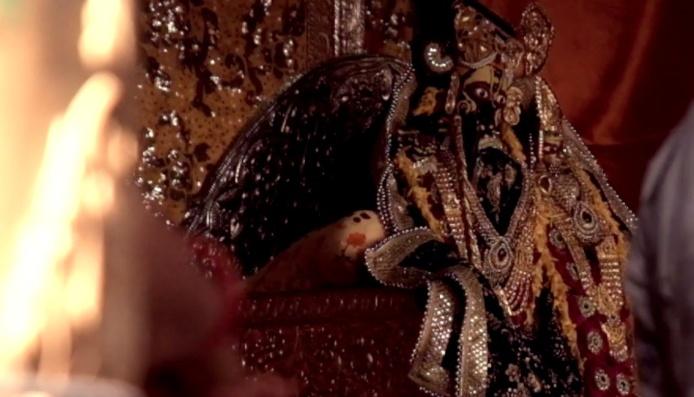
I would like to speak about this name of Rādhā, Govinda–Mohinī—She who bewilders Kṛṣṇa. Her love is so great that She causes Kṛṣṇa to forget Himself. When we leave from here later today, we will go to another lake— Pili Pukur. I won’t tell you all the details of that pastime. Oh, we will wait for one week to arrive at that place. But let me tell you this much, at that place Kṛṣṇa became completely bewildered as to His own identity. He became completely bewildered by Rādhā’s Prema for Him and temporarily He assumed Rādhā’s own complexion, Her duty, and Her mood—Her Bhāvana. You will have to wait to find out how that happened; there is a cliffhanger for you. Yeah, you are going to wait in anticipation for those details. Let’s suffice to say that Kṛṣṇa became bewildered. He merged in Rādhā’s mood and complexion and He left that lake wandering through the forest of Varṣāṇā saying, “Hey Kṛṣṇa, where are you?” A golden-colored Kṛṣṇa calling out for Himself; Looking for Himself. Rādhā’s love so bewilders Kṛṣṇa. He is unable to comprehend its breadth and its depth.
That He appears in this world as Śrī Caitanya Mahāprabhu to answers three questions:
- What is Rādhā’s Prema—what is the nature of Rādhā’s love?
- What is it about Kṛṣṇa’s sweetness that attracts Rādhā?
- What is the bliss that She experiences in loving Him?
To answer these questions, Kṛṣṇa who is blackish in complexion, He appears in a golden form as Gaurāṅga. Internally, Kṛṣṇa—externally like Śrī Rādhā in mood and complexion and mad with love for Śrī Kṛṣṇa, He tastes the nectar of Kṛṣṇa Prema. Day and night He chants Kṛṣṇa‘s name feeling intense pangs of separation from Kṛṣṇa. That is Vipralamba Bhāva or Love in separation; and in this intense mood of loving separation from Kṛṣṇa, His experiment is to understand, get responses or answers to these questions that bewilder Him. In this, He very mercifully, very kindly distributes that very love to anyone who will take it. He is Mahāvadanyāya Avatāra—that is the most munificent incarnation. Kṛṣṇa has so many incarnations, but in this incarnation of Caitanya Mahāprabhu, He is Mahāvadanyāya, the most merciful, because He is in the mood of His own devotee —Śrī Rādhā.

Generally we have to be qualified to get Kṛṣṇa’s mercy. But when Kṛṣṇa is drunk with love; He is drinking the nectar of that love, and it’s falling around Him. He is not discriminating who will taste that nectar with him. If the king decides to give away the most valuable treasures in his treasury; If the King becomes drunk and decide to give away valuable jewels from the treasury, who can stop him? When Kṛṣṇa becomes immersed in a mood of Śrīmatī Rādhārāṇī and freely gives this love, who can stop Him?
That is Śrī Caitanya Mahāprabhu, the most kind, the most merciful incarnation of Godhead; so if we want to approach Kṛṣṇa, if we want to enter His eternal pastimes in Vrajadhama, we approach Him through Caitanya Mahāprabhu, we approach Him through Śrīmatī Rādhārāṇī and Her maid-servants.
Śrīla Rūpa Gosvāmī explains,
tan-nāma-rūpa-caritādi-sukīrtanānu-
smṛtyoḥ krameṇa rasanā-manasī niyojya
tiṣṭhan vraje tad-anurāgi-janānugāmī
kālaṁ nayed akhilam ity upadeśa-sāram
The essence of all advice is to hear Kṛṣṇa’s pastimes and glories, to chant them, to engage our mind on meditating on them, and gradually, to become immersed in this Kīrtana, Śravaṇa and Smaraṇa. But to engage in this Sādhana under the direction or under the guidance of Kṛṣṇa’s eternal devotees—that is called ‘janānugāmī ‘ –to follow in the footsteps, to follow in the mood of residents of Vṛndāvan. Anurāga—means follow in their mood. We want to approach Kṛṣṇa; so we are advised to approach Him in the mood of the residents of Vṛndāvan —as Caitanya Mahāprabhu did. We are advised to approach Kṛṣṇa for cultivating that mood of His eternal associates—always with guidance and in this process as a servant of the servant of the servant we will be able to enter; we will be granted entry.

The famous story of Lakṣmī is that She performed great penance and austerities to enter into the Rasa–Līlā. Kṛṣṇa appeared and asked, “What can I do for you?” “I would like to participate in your Rasa dance.” “That’s very nice, but this isn’t the process. Penance and austerity will not give you entry into the Rasa dance.” “Well, what is the process?” “The process is to follow my eternal devotees who are participating in the Rasa dance; — to follow in their mood, to take up their service, to receive their mercy.” Lakṣmī—She is a goddess, born from the ocean of milk, so She didn’t take to this very advice and So Kṛṣṇa said you can be a golden line on my chest. But you can’t enter into my Rasa dance; so She didn’t follow that process. We are therefore advised that we must follow this process of following in the footsteps of servants of the servants of the servants of the residents of Vṛndāvan.
Caitanya Mahāprabhu prayed: “Gopī-bhartuḥ pada-kamalayor dāsa-dāsānu-dāsa” – I am the servant of the servant of the servant of the lotus feet of the Gopīs of Vṛndāvan. As followers of Śrī Caitanya Mahāprabhu, we are followers of Rūpa Gosvāmī, i.e. Rūpānuga – followers of Rūpa Gosvāmī, who is Rūpa Mañjarī, the maid-servant of Śrī Rādhā. All of our Ācāryas in the line of disciplic succession, they are in the spiritual identity—they are servants maids of Rūpa Mañjarī. Thus we followers of Rūpa Gosvāmī, followers of Bhakti-Siddhānta Sarasvatī Ṭhākur, followers of Śrīla Prabhupāda, we aspire to the service of Śrīmatī Rādhārāṇī under the guidance of Rūpa Mañjarī. That is our aspiration. That is our highest objective. It is our invitation as well. The opportunity to visit Varṣāṇā, to chant here, to associate with devotees under Gurudeva’s guidance here, the opportunity to visit so many holy places in the month of Kārtik, it is a great opportunity for all of us, who despite of our lack of qualifications, somehow or other find ourselves here by the mercy of the devotees. Somehow or other, by this special mercy, as we express our eagerness and our sincerity, then that mercy will deliver to us unto, what is apparently impossible to achieve.
By Śrīmatī Rādhārāṇī’s grace, we can be given a place in service in the spiritual world, and as a servant of the servant of Śrī Rādhā and Her associates.

Kṛṣṇa says in the Gītā that He reciprocates with everyone according to their devotion. Karmīs approach with material desires, and He gives them material rewards; Jñānīs approach desiring liberation and He gives them that. Devotees approach desiring devotion and He reciprocates. Like this according to devotion of devotee Kṛṣṇa manifests Himself. Śrīmatī Rādhārāṇī, She loves Kṛṣṇa the most and so the highest manifestation of Kṛṣṇa—that is the most loving and affectionate Kṛṣṇa is manifest only before Śrīmatī Rādhārāṇī. Can we ever hope to see that Kṛṣṇa? It is possible. We can never love Kṛṣṇa as Śrī Rādhā does with the same intensity. In principle, we would never see that Kṛṣṇa. But we can stand behind Śrī Rādhā; we can stand behind Her servant and Her servant, Her servant’s servant’s servant ; somewhere standing behind the servants of Her servant, standing behind our Spiritual Masters,—we can actually see that Kṛṣṇa. That Kṛṣṇa who takes delight in Śrī Rādhā— ‘Govinda Ānandinī’, that Kṛṣṇa for whom Śrī Rādhā is everything— ‘Govinda Sarvasva’, that Kṛṣṇa whom Śrī Rādhā has bewildered—‘Govinda–Mohinī’, that Kṛṣṇa we will be able to see and serve by following as a humble servant of our Spiritual Masters. Only by Śrīmatī Rādhārāṇī’s mercy!

Vṛndāvanesvari Śrīmatī Rādhārāṇī ki – Jaya!
Śrīmatī Rādhārāṇī ki – Jaya!
Śrī Varṣāṇā Dhām ki – Jaya!
Vrajendra-Nandana Kṛṣṇa ki – Jaya!
Govinda-Mohini Rādhā ki – Jaya!
Govinda-Ānandinī Rādhā ki – Jaya!
Govinda-Sarvasva Rādhā ki – Jaya!
Śrīla Prabhupāda ki – Jaya!
Nitai Gaura Premanande – HARIBOL!
Jaya-Jaya Śrī Rādhe…………………..Śyāma!



